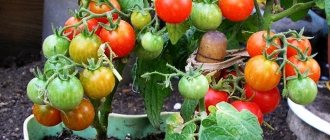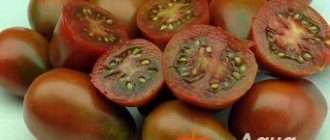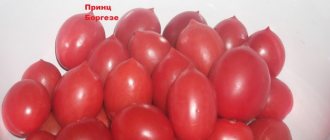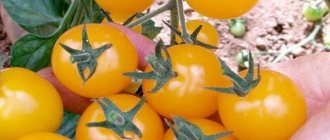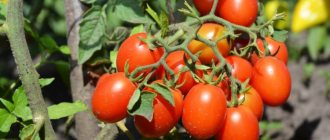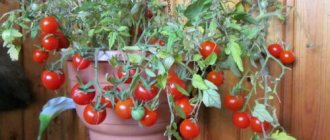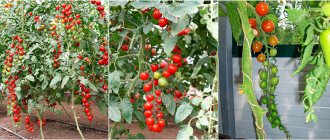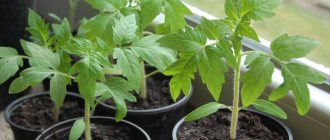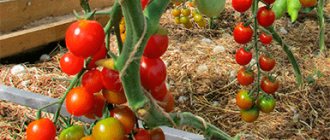Miniature bushes in pots with bright cherry tomatoes have become not only a tasty addition to the vitamin table, but also a decoration for the home interior. Abundantly fruiting low-growing bushes are an unusual feature in window design; this original vegetable crop looks no worse than a flowering houseplant. But there are much more benefits from it - delicious tomatoes will go great in salads and for winter preparations. The fashion for growing small Bonsai tomatoes at home has appeared in the last two decades, as soon as the variety was developed.
History and description of the variety
At the end of the last century, agricultural specialists introduced a wonderful new product - cherry tomatoes, called Bonsai. The breeders of this seed company have developed a tomato variety that is most suitable for growing at home and on balconies with a long fruiting period. The date of its entry into the State Register was 2001, after which Bonsai turned out to be the favorite of many vegetable growers who practice indoor growing of vegetables.
Growing tiny tomatoes at home has become a real hobby for many people who prefer a window garden to their dacha. Red fruits growing abundantly on a low-growing bush are an attractive sight. It is not surprising that the demand for the variety led to the appearance of its varieties - F1 Bonsai micro, this hybrid with small bushes 15 or 20 cm high bears fruit well. Tomatoes grow well in small 2-liter flower pots, in hanging flowerpots or wooden boxes on the balcony.
Where to grow?
Bonsai is far from the most suitable variety for growing in open ground due to its poor resistance to temperature changes and numerous diseases (for example, late blight). It is preferable to keep it indoors, because this is exactly what this variety was bred for.
Bonsai tomatoes are suitable for growing at home, both on the windowsill and on the balcony or loggia.
It is preferable to place a tomato pot on a window facing south or southeast. In winter (and in temperate latitudes - all year round), you can make up for the lack of sun by using fluorescent lamps. Containers with seedlings should not be constantly turned to the Sun with one side, otherwise they will grow asymmetrical.
Characteristics of the variety
The height of a bush of indoor cherry tomatoes is no more than 30 cm. It has an attractive decorative appearance, a strong trunk, like a standard tree, and does not need to be tied up. The bush produces side shoots; they and the top of the bush are usually pinched to stimulate abundant fruiting. From the moment the seedlings emerge from the planted seeds until the fruits ripen under indoor conditions, it takes from 85 to 90 days; this is a very early ripening variety. The advantage of growing miniature tomatoes at home is that you can plant seeds and get a harvest at any time of the year.
Size of fruit tomato bonsai
The Bonsai tomato has a round shape, bright red color, smooth skin and dense flesh. The mass of a small tomato is about 30 g; a cross-section shows that it has two seed sacs with seeds. The dwarf bush bears fruit abundantly; the harvest can be eaten directly from the branches even in winter. Tomatoes have a wonderful taste due to their high content of sugars and organic acids; they are juicy and crunchy. One bush gives a yield of 500 g to 1 kg.
The peculiarity of Bonsai tomatoes is that they can be grown not only on a windowsill in pots, on a balcony, but also in a greenhouse or in open ground. The main condition for their growth is an abundance of sunlight.
In indoor conditions, tomatoes ripen best on windows facing south; if this is not possible, the bushes need an additional source of lighting. The characteristics and description of the variety allow the gardener to expect a harvest of miniature tomatoes even when grown outdoors. In this case, you need to take into account the nuances of the weather, the duration of the sun's heat and remember the risk of disease.
Brief information about the variety
- Fruits and bush : standard plant, compact, with a height of up to 30 cm, fruits weighing up to 60 g, red in color.
- Productivity : up to 2 kg per bush with proper care.
- Resistance : the variety is resistant to standard nightshade diseases and survives the lack of sunlight without loss.
- Distribution : can be grown throughout Russia, but the southern regions are preferable.
- Application : used in salads, for preservation.
- Planting : seedling method with a standard pattern of 70x30/40 cm, up to 9 plants are planted per 1 m².
- Soil : light and with nutrient impurities, such as ash or peat.
- Care : does not require pinching, the top leaf is pinched, the frequency of watering depends on the air temperature, but the standard is once a week.
- Ripening period : 90 days from the moment the first shoots appear, the fruits ripen at the same time.
Features of cultivation
The main advantage of growing Bonsai tomatoes is that at home they can bear fruit throughout the year, regardless of the season. At the same time, indoor tomatoes grow equally well both in northern regions and in southern latitudes. It is only important to follow all the rules of agricultural technology for this crop.
Seed selection
To determine which Bonsai tomato seeds are suitable for sowing, they are wrapped in a damp cloth or gauze. It is placed in a plastic bag or container and left warm. After two or three days, the seeds should sprout. Germinated seeds are ready for planting. Those seeds where sprouts have not appeared are not suitable for cultivation.
Sprouted seeds in napkins
Soil preparation
Many gardeners prefer to purchase ready-made soil for planting tomatoes; it is supplied with the necessary components for their successful cultivation. You can prepare suitable soil with your own hands. For this you need a mixture:
- compost;
- garden soil;
- humus;
- a little ash;
- a little sand.
Before filling the pots with soil, it is necessary to make drainage from expanded clay at the bottom, and a thin layer of sand on top. Only after this can the pots be filled with soil.
Sowing
Sprouted seeds are sown in one container at a distance of 3 cm. They are covered with a thin, 1.5 cm layer of soil. Lightly water with warm water and cover with plastic wrap. Until the first shoots appear, the planted seeds are kept warm at a temperature of 25-26 degrees. Usually all seeds germinate on the fifth day, after which the temperature should be lowered by 5-6 degrees.
During this period, it is necessary that the surface of the soil with the emerging seedlings be well illuminated. If there is not enough sunlight, you need to direct the light of a fluorescent lamp to the emerging sprouts at a height of 25 cm from the top of the plants that need constant lighting.
Care and watering
When the seedlings grow, they do not require fertilizing. The container is replenished with soil as the plants grow. It is important to adhere to the temperature regime; it should be around 20 degrees during the day, and drop no more than four degrees at night. For successful seedling growth, the container should be turned on different sides towards the sunlight.
During this period, caring for and growing the Bonsai variety also involves proper watering of the sprouts. They do not need to be watered too often, preferably once a week. To do this, the water must be settled; it is better to water it in the morning. For irrigation, warm water at room temperature is required; cold water is strictly contraindicated.
Fruit characteristics
A small bush strewn with beautiful fruits of edible tomatoes in a room or on a balcony, of course, is unlikely to leave anyone indifferent, even those who are very far from plant growing and gardening. Therefore, it is not surprising that people are willing to make many sacrifices to achieve such a result. Bonsai tomatoes can be characterized as follows:
- The fruits have a regular round shape and a smooth attractive surface;
- When unripe, tomatoes are light green; after full ripening they become bright red;
- The pulp is quite dense, sometimes even crispy and juicy, the skin is thin;
- The number of seed nests is no more than two;
- Tomatoes are small in size: slightly larger than grapes and weighing about 25-28 grams;
- The taste characteristics of these tomatoes have some dependence on growing conditions (amount of sun) and care, but on average they are rated as “good” and “excellent”. The fruits contain a sufficient amount of sugars and dry matter;
- Tomatoes of this variety are best consumed fresh, enjoying them straight from the bush. They are also good in salads and in twists. Despite the fact that the skin of tomatoes in jars sometimes bursts, the dense structure of the fruit is preserved.
Transplanting seedlings
Seedlings begin to be transplanted into separate pots only when they have two large leaves. Each plant is picked from a common container into a small peat or plastic cup. After the third leaf appears, the seedlings will need to be transplanted into larger containers. The main stem of each bush is pinched, thereby stimulating the growth of side shoots.
Transplanting seedlings into separate containers
To finally transplant the grown seedlings, pots with a capacity of up to 2 liters are filled with soil, not forgetting about the mandatory drainage. The plant does not need larger pots. Each seedling is removed from the soil along with a lump of earth and planted in a pot where indentations have been previously made. The roots are covered with soil, the surface of the soil is made dense. Planted bushes should be watered only with warm water, the excess of which should drain through the hole at the bottom of the pot.
At two months of age the bushes should begin to bloom. Their flowers are pale yellow and inconspicuous. This tomato variety is self-pollinating. But it would be useful to shake them every day after the inflorescences appear so that the fruits set faster.
How to grow tomatoes at home on a windowsill?
Growing Bonsai tomatoes in pots is no more difficult than growing any indoor plants. All you need for this:
- seedling;
- properly prepared soil;
- containers.
Otherwise, indoor tomatoes are unpretentious, and basic step-by-step instructions will help you plant them correctly.
Soil preparation
Heavy (clayey) soil is not suitable for Bonsai tomatoes. To plant a crop, it is better to buy ready-made soil, although you can make it yourself by mixing:
- wood ash;
- fertile soil (cleared of organic debris);
- peat;
- some river sand.
The base for the soil should be thoroughly mixed and then disinfected with a weak solution of manganese.
Important! Not only the soil needs to be treated for disinfection, but also the containers in which the tomatoes will grow.
Step-by-step instruction
Tomato seedlings are grown in plastic or wooden boxes and then transplanted into separate pots. The entire culture propagation procedure is carried out in accordance with the following step-by-step instructions:
- Moisten Bonsai seeds and wrap them in a wet towel (napkin). The sprouts should hatch in 1-2 days.
- Place the sprouted seeds to a depth of 1 cm in moist soil. The soil should be sprayed with small portions of water 2-3 days before planting tomatoes.
- Cover the boxes with seedlings with film or glass. After 5-6 days, when the shoots appear, you need to select the strongest ones from the sprouts and pin them.
- Prepare pots for young tomatoes: fill the container ¼ full with expanded clay or other drainage materials, then top up with prepared soil.
- Plant the selected seedlings in moistened potting soil and water.
After this, all that remains is to wait for the sprouts to strengthen and the bush to grow. During this period, it is very important to provide the crop with optimal lighting.
Important! If you select high-quality seeds, you can skip the first stage of preparation for planting - they will germinate without additional moisture. If there are doubts about the quality of the material, then preliminary germination is necessary. It is also advisable to carry out preventive treatment to disinfect suspicious seeds.
Planting options
The characteristics of the Bonsai variety allow this dwarf tomato to ripen not only indoors, on a loggia, in a greenhouse, but also in open ground. Vegetable growers who want to get bushes with small fruits should definitely get acquainted with how to grow cherry tomatoes in different growing conditions.
Tomato Bonsai in open ground
In the greenhouse
When the greenhouse is heated, you can plant in it throughout the year, just like at home. It's another matter when the greenhouse is not heated. In this case, tomatoes of this variety are planted only in April. The agricultural technology used is the same as when planting in a vegetable garden. The distance between seedlings should be at least 0.5 m. An important element of caring for bushes is regular ventilation of the greenhouse and inspection of seedlings; these simple conditions will help avoid the occurrence of diseases.
At home
Most often, Bonsai tomatoes are grown at home in pots. If you want to get a harvest in the summer, then they are planted in March or April. Someone wants to plan so that the tomatoes are ripe for the New Year holidays; in this case, planting is carried out in October. Indoor tomatoes feel great on a glassed-in loggia or balcony. Caring for them is no different from when tomato bushes grow on a windowsill.
The compact hybrid F-1 Bonsai micro, planted in a hanging pot, looks very impressive as a hanging plant. The small size of the bush, up to 20 cm high, and the hanging clusters of small tomatoes with a glossy surface are admirable. Such an unusual and tasty decoration on the balcony makes its design unusual and eye-catching.
In the open ground
Bonsai tomatoes are intended for growing indoors, but no one bothers to plant them in the garden or even in flower beds as a healthy and tasty ornamental plant, because their yield for a garden crop is low.
When planting in a summer cottage, seedlings for this variety must be taken care of in advance; the seeds are sown in boxes at a short distance two months before planting in the soil, then they are picked. The seedlings must grow and become stronger before planting in open ground, but it must be remembered that these small bushes will not tolerate night frosts in the soil.
Bonsai tomatoes are planted up to 5 bushes per square meter. It is important that potatoes, peppers, eggplants, and other types of tomatoes do not grow in the beds before this. Caring for this varietal species in the garden is no different from caring for it at home, when the bushes grow on the windowsill.
Nuances of cultivation
Agree, harvesting your favorite vegetable without leaving home is very convenient. But few people thought that this method of growing is somewhat different from the usual one. But you shouldn’t be afraid in advance; if you pay attention to yourself, the culture will only delight you, and it’s quite easy to care for a potted plant.
It is best to grow Bonsai using seedlings. The originators recommend sowing the seeds in mid or late April. But in the southern regions this procedure can be done in the first half of March. Seed preparation is carried out in the usual way, as well as the process of growing seedlings. Two-liter pots with holes for water drainage are suitable for planting, so the plant will not take up much space. A universal primer is suitable, but before use it must be disinfected by calcining it in the oven or spilling it with a dark pink solution of potassium permanganate. Be sure to lay a three-centimeter layer of drainage at the bottom of the pot.
A miniature Bonsai planted in a flower pot will not take up much space
And now about the promised nuances:
- In order for Bonsai to develop well and bear fruit, provide the plant with the brightest place on the balcony, loggia or windowsill. The culture will feel most comfortable if the windows face south or east. But protect the bush from drafts!
- Watering should be sufficient to maintain the soil in a moderately moist state. Excessive humidity will lead to the development of fungal diseases, and frequent periods of drought will lead to the falling of flowers and ovaries. Pay special attention to watering - at home, especially on a hot day, the soil in a small pot dries out quickly.
- Nutrition is added 10 days after transplantation. And then, according to the scheme, once every 2-3 weeks, use universal mineral fertilizers, for example, Kemira or Kemira-lux . During the growth period, you can slightly increase the nitrogen content in the working solution. When the harvest begins to ripen - potassium and phosphorus. But don’t get too carried away; prepare the solution strictly according to the instructions.
- Thanks to the stable trunk, there is no need to tie up the bush; pinching is also not carried out. To speed up the ripening of tomatoes, you can remove the leaves under the first fruit cluster. But do not do this right away, but a couple of leaves a week so that the plant does not experience shock.
- During the flowering period, you need to help the plant with pollination . To do this, during the flowering period you just need to lightly shake the bush, holding it by the stem. It is especially important to do this if the tomato is growing in a room where pollinating insects cannot fly.
Bonsai bears fruit well on a lit balcony
In open ground, the Bonsai tomato is cared for like other low-growing varieties. You can plant ornamental bushes not only in a regular garden bed, but also in a flower bed, or along paths. A good option is to plant dwarf bushes at the feet of tall ones to compact the plantings . And planting together with marigolds will protect against the invasion of insect pests.
Recent Entries
Lilac perennials that are beautiful, compact and do not crowd out other plants Why when buying seedlings you should not take the sellers’ word for it and how to determine the age of the plant using 3 signs Tomato seedlings have turned purple or whitish: why the color has changed and how to save the plants
Planting density is 7 – 9 plants per 1 m2, or according to the scheme 70 by 30–40 cm.
In the southern regions, the Bonsai tomato shows excellent results in open ground
Seedling care
When the grown bushes are finally transplanted into pots, they require a special temperature regime and real warmth from 25 to 28 degrees. If the heating season has not yet ended in the spring, such temperatures are possible on the windowsills, near the radiator. Water the plants generously 2-3 times a week, making sure that excess moisture flows into the pan.
We must not forget about the mandatory loosening of the soil after watering; this allows air to freely penetrate to the root system of tomato bushes and will speed up the flowering process.
Following the appearance of modest yellowish flowers, tomato ovaries form on the bushes. The plant does not need to be tied up. During this period, the side shoots on the bushes that are not yet flowering are removed in order to speed up the ripening time of small tomatoes.
As tomatoes ripen, they gradually change color from green, then orange, to bright red fruits that can be eaten. Some lovers even enjoy green or orange tomatoes that are not fully ripe and make preparations from them.
Transplanting seedlings and care
For each plant, allocate a separate container: flower pots, long boxes. Before transplanting seedlings to a permanent location, it must be watered abundantly so that this process does not harm the young root system.
The volume of soil for one plant should be at least 4-5 liters.
An important characteristic of the variety: it loves sunlight. Therefore, it is good if at first the crops are placed on the sunny side. It is important to monitor the condition of the soil: it should not dry out. If the weather is too hot, the soil needs to be watered daily (but without waterlogging).
Fertilizing improves fruit quality
If these minimum recommendations are followed, after some time female and male flowers will appear on the bushes - small and pale.
Tomato flowers are bisexual; they do not have male or female flowers. Each flower has stamens with anthers (male organs) and a pistil (female organ).
Thanks to this, the procedure of artificial pollination is not required. Although many shake off the pollen to be safe and confident in the ovaries of tomatoes.
When forming the ovary, you should remove the side shoots on which flowers do not appear. This may negatively affect the appearance of the bush, but will have a positive effect on fruiting.
With sufficient watering and good lighting, the flowers on the bushes are replaced by small tomatoes, which change color from green to yellow, and then to orange and red.
Feeding
To make the tomatoes tasty and juicy, during the formation of the fruit, pour 2 tbsp under the bush. l. wood ash. The use of nitrogen fertilizer has a positive effect on the intensity of fruit development and the quality of green mass. Even if harvesting is not planned, high-quality fertilizing will give the bush a beautiful and healthy appearance.
The quality of tomato fruits (sugar content, fleshiness) is affected by fertilizing with phosphorus and potassium fertilizers.
Watering
Watering once a week is considered optimal. Otherwise, the soil may become waterlogged, which will cause the green mass of the bush to turn yellow and increase the likelihood of developing fungal diseases. When the plant needs additional watering, you can spray the leaves with a spray bottle.
Tomatoes do not like high humidity on the leaves; this leads to the development of various fungal diseases.
There is one secret that allows you to get a harvest ahead of schedule. To do this, you should tear the root system - pull up the stem of each bush so that the small roots come off and no longer take nutrients from the green mass. After the planting has been damaged, it is necessary to water and hill up.
Tomato is a perennial plant by its biological nature. If grown indoors or in a year-round heated greenhouse, it can grow and bear fruit for several years.
Pros and cons of the variety
The Bonsai variety has many advantages that make it attractive to lovers of growing vegetables:
- harvesting in an apartment or on a loggia;
- easy care;
- no supports or garter required;
- shade-tolerant;
- resistance against diseases;
- long fruiting period;
- excellent taste;
- decorative beauty of bushes with fruits.
A minor drawback is that the yield of the dwarf variety is not very high.
Advantages and disadvantages
For those who want to decorate their home and have a harvest, the Bonsai variety is the most suitable, given a number of its advantages:
- ease of cultivation;
- suitability for rooms, loggias, balconies;
- there is no need for garters and supports;
- excellent taste;
- high commercial quality hearths.
Reviews from vegetable growers and those who decorated their homes with pots of tomatoes instead of flowers are unanimous - the variety is excellent for indoor conditions and has no drawbacks.
Possible diseases and pests
When cherry tomatoes are grown on a windowsill in room conditions, where the required temperature is maintained and the correct watering regime is observed, there are no prerequisites for the plants to be affected by fungal diseases or pests. Experienced vegetable growers who cultivate the Bonsai variety at home do not complain about such problems. It is important that the plant always has good lighting and the leaves do not begin to turn yellow. Proper care of plants ensures their strength and healthy development, so tomatoes do not require treatment with insecticidal preparations.
An amazing variety of dwarf cherry tomatoes Bonsai will delight those who love growing indoor vegetables. Easy care, early maturity of the variety, the ability to cultivate miniature tomatoes
You can learn more about growing cherry tomato bonsai from the video
Rules for growing tomatoes at home
For successful growth in the house, the Bonsai tomato variety needs certain conditions:
- southern and eastern location;
- landing capacity of at least one liter;
- enriched and breathable substrate;
- lighting in winter.
Similar requirements are put forward when growing on glazed balconies and loggias. Additionally, it is necessary to maintain the temperature regime: during the daytime – 21-24 °C, at night – 15-18 °C.
Advice! It is better to purchase pots for Bonsai tomatoes specifically so as not to spoil the overall picture - a decorative bush with a spectacular scattering of mini-tomatoes will look unsightly in an old pot. The most suitable would be decorative containers made of ceramic or plastic.
Pollination rules
The plant copes with pollination on its own, but help will be helpful. To do this, just shake the branches slightly during the flowering period every 3-4 days. It would be a good idea to water after the procedure so that the pollen germinates on the stigma of the pistil.
The Bonsai tomato has both male and female reproductive cells and therefore does not require artificial pollination.
A beautiful colored bush on the windowsill will not only decorate your home, but will also allow you to enjoy the taste of fresh tomatoes in late autumn or even winter.
Agricultural technology
Warm-grown Bonsai tomatoes, the characteristics and description of the variety of which are discussed in detail above, have seed material that is no significantly different from other tomatoes. They may differ slightly in size and are sometimes treated with special means before sale to ensure their reliable germination.
Siberian tomatoes
Treated seeds have a difference in color, which is immediately noticeable. Such seed material, as a rule, does not need additional preparation and soaking. A typical example in this sense is the seeds of the Bonsai-micro-f1 variety.
Breeding seedlings and replanting them
It is necessary to sow seedlings in compliance with the following rules:
. Seeds ready for scattering are placed in holes that are made in advance in well-moistened soil (their depth should not exceed one centimeter);
- After this, you should intensively water them from a watering can with a fine mesh, after which the container with the seedlings is transferred to a well-lit and not very warm place;
- Regardless of the time of year in which the seedlings are formed, in cloudy weather it is recommended to use artificial lighting immediately after the grains hatch.
Note ! Seed pipping in this species occurs quite quickly, and they germinate very quickly (within about a week).
After a real tomato leaf appears on the miniature sprouts, you can begin to plant them in separate 0.2-0.3 liter containers. To do this, you can use any plastic jars with specially made drainage holes in the bottom.
Vegetation of seedlings
By the time several pairs of miniature leaves appear, the grown bushes should be carefully transplanted into a larger container (about one liter). In addition, at this stage of growth, you can start feeding them with any type of fertilizer suitable for indoor flowers. And already a day after transplanting, you should pinch the stem of the tomato bushes in order to pinpoint it (form side shoots).
Tomatoes of this variety do not require too large containers; to continue their normal growth, volumes of about 2-3 liters are quite sufficient. The final planting of bushes that have reached the age of about 1.5-2 months is carried out in them. At about two months of age, they begin to actively bloom (and sometimes can set fruits that are noticeable to the eye).
Additional Information. Tomato flowers of this variety can be pollinated independently. However, for greater confidence, experts recommend periodically shaking the flower brushes, which provides better conditions for the development of fruits.
Saplings
Their first inflorescence usually appears after the third pair of leaves has formed, and all subsequent ones occur in random order. According to experienced gardeners, during the flowering process it will be necessary to feed the tomatoes one more time, as well as additionally pinch the side points of the sprouts (if they grow strongly upward).
For systematic watering of tomato bushes grown in apartment conditions, it is recommended to use only warm and well-settled water. The frequency of this procedure depends on the ambient temperature and air humidity (it increases with an increase in the first indicator and a decrease in the second). Overwatering in this case is extremely undesirable (this applies not only to seedlings, but also to fairly mature bushes). Before carrying out the next watering procedure, it is best to wait until the top layer of soil has completely dried.
Care
Tomato bushes are a determinate species. Their height rarely goes beyond 30 centimeters. The plant has a strong, durable trunk that can easily support a dozen fruiting clusters. There is no need to tie up the plants. However, in order for plants to grow correctly, they need to be shaped. To prevent the bush from stretching upward, the top is usually pinched.
Although the variety belongs to the standard variety of tomatoes, which are characterized by self-regulation of bush growth and slow growth of stepsons, stepsoning still needs to be carried out, although many vegetable growers do not do this. However, if you do not remove excess shoots, the bushes will become fat, growing greenery to the detriment of the formation of fruits and their development. It is necessary to carefully remove all shoots, leaving only two or three of the strongest ones. Bud buds will form on them as soon as the plant stops growing upward.
One of the distinguishing features of Bonsai is its resistance to low light. This property is very useful when growing indoors, when very little sun falls on the plants. But you should not take this statement as an axiom, because, like any other crop, the tomato still needs light. In the light it grows faster and better, more ovaries are formed, and the fruits ripen faster.
Tip : In order for plants to grow in beautiful shape, they need uniform lighting from all sides. Therefore, it is necessary to install the pots where the sun will illuminate them best or regularly turn the pots towards the sun so that each side of the bush receives its portion of light.
The tomato is a self-pollinating plant, but it can be helped to cope with this task. To do this, you need to lightly shake the brushes, freeing the flowers from pollen. Immediately after this manipulation, you need to water the plant so that the pollen attaches to the pistil.
At various stages of plant development, tomatoes need to be fertilized. Feeding should be carried out at least three times per season. In the first period before flowering, the bushes need nitrogen-containing preparations. For the correct formation of fruits and their rapid ripening, the bushes are fed with potassium and phosphorus preparations. You can also sprinkle the ground under the bush with wood ash.
Most often, vegetable growers view growing tomatoes indoors as a fun and exciting experiment. However, the experience of cultivating such a fastidious crop as a tomato can only be successful if the cultivation of ornamental tomatoes is treated with all the importance of the moment. Otherwise, you will only waste time and nerves.
https://youtu.be/mdMQ4J_2OMg
Preparing seeds for planting
Many gardeners are of the opinion that hybrid seeds purchased in bags do not require special preparation. Seed material should be disinfected if it is purchased from strangers.
Packaging with Bonsai tomato seeds
Common preparation involves moistening the seeds and wrapping them in a damp cloth. In 1-2 days the grains will be ready for planting.
High-quality seeds germinate without soaking, so the preparatory process can be easily simplified.
How to care for tomatoes
Tomatoes love water, so they need to be watered constantly:
- Rooted seedlings are irrigated every 3 days until they start to bear fruit. One plant should have 5 liters of water at room temperature.
- When tomatoes ripen, their bushes are watered once a week. In this case, the fruits will be tasty and not watery.
After watering, the soil in the root zone of tomatoes is cleared of weeds. Then it loosens. This improves plant nutrition, as well as moisture and air exchange. After hilling, the beds can be covered with mulch. It will prevent moisture from evaporating from the soil.
This variety is formed into 2–3 stems. In this case, the crop yield will be maximum, since the nutrients will not be dispersed throughout the thickened bush, but will be directed to the development of the fruit.
During the growing season, tomatoes are fertilized with minerals:
- Immediately after rooting the seedlings in open ground, they are fed with a nitrogenous preparation. This can be ammonium nitrate, urea, ammophos. They contribute to the rapid development of culture.
- After the tomatoes bloom, they are fertilized with a phosphorus-potassium mixture. The drug will give the crop the strength to set the maximum number of fruits.
- For the third and fourth time, tomatoes are fertilized when fruits are set and filled. In this case, a phosphorus-potassium complex is also used.
To prevent diseases, tomatoes are sprayed with fungicides 1–2 times a month. It could be:
Growing a Bonsai variety in a garden bed
Many gardeners successfully grow this ornamental variety in open ground. It is noted that this tomato grows in street conditions no worse than on the balcony. Just like other varieties, Bonsai is grown through seedlings.
Seeds are sown in March so that by the end of May the seedlings have become stronger and can withstand transplantation and environmental changes. If you decide to grow Bonsai in a greenhouse, then you can plant it in a greenhouse at the beginning of the month. In open ground, however, you will still have to protect low-growing bushes from cold and winds. Therefore, especially at first, the seedlings need to be covered with a film canopy at night. Bonsai bushes are planted infrequently; gaps of 30 centimeters are left between bushes. There should be 5-7 bushes per square meter. Before planting, the soil needs to be prepared: rid it of weeds and remnants of previous beds, dig it up, and apply organic and mineral fertilizers. And although Bonsai is not afraid of the shade, it is still better to plant the seedlings in a sunny, quiet place. This way it will definitely give a bountiful harvest.
Tip : a tomato bed should not be built where potatoes, peppers or eggplants previously grew.
Sowing seeds
It is better to sow seedlings in the last days of February. Ordinary soil is not suitable for decorative tomatoes, so you can buy a specialized soil composition in the store or, in order to save money, prepare it yourself. A fertile soil mixture consists of three components: humus, peat and soil in equal quantities (sand can also be added). You can add mineral fertilizers.
Pre-purchased seeds need to be soaked in warm water. In a humid environment they will swell and sprout faster in the ground. You can also spray the seeds with a solution of water and potassium permanganate for disinfection purposes. Only then should the seeds be dried. As experience shows, you don’t have to carry out these manipulations, the shoots will still be friendly. However, only the timing of their appearance will shift by about two weeks.
Advice: if purchased seeds are not painted in the usual light beige color, this means that the manufacturer has already treated the seeds with special disinfectants and growth stimulants. Such seeds do not require any further manipulation.
For seedlings, seeds are sown in common boxes or special peat cups, which are very convenient to use. When planting in pots or in a garden bed, the bush does not have to be pulled out of the container, but immediately planted in the cup itself.
Seeds are sown in furrows, deepening the seeds a centimeter, no more. You can place two seeds in one place, and then leave the strongest shoot when germination occurs.
To make the bushes grow more luxuriant, you can pinch the lateral shoots.
At first, you need to water the seedlings carefully to avoid washing out the seeds. It is better to irrigate the soil with a spray bottle.
Bonsai seeds usually germinate very quickly and amicably. If the boxes with seedlings are constantly illuminated (you need to use additional lighting with a fluorescent lamp), then within the first week the first sprouts will appear.
At the seedling stage, watering can be done once a week. And in order for the sprouts to grow faster and become stronger, they need to be provided with an abundance of sunlight. The room should be on average 20-21 degrees Celsius, and at night the temperature can be dropped to 16 degrees. Too high a temperature will create a waterlogged microclimate, so you need to regularly ventilate the seedlings, otherwise fungus will develop.
During the seedling period, you can fertilize with minerals and vitamins.
As soon as the sprouts acquire two mature leaves, the tomato bushes are planted in separate containers. This usually occurs 23-25 days after sowing the seeds. Picking is best done in small plastic cups.
Tomato seeds Gavrish "Bonsai" - reviews
NatashaK
https://7dach.ru/Tangeya/otzyvy-o-semenah-proizvoditelya-gavrish-107226.html?cid=362271
My favorite tomato is the miniature Bonsai. I plant seedlings; out of 12, 1-2 may not sprout. Begins to bear fruit earlier than anyone else, sweet, juicy, with a lot of clusters. It bears fruit well until frost, has not suffered from any diseases, and the decorative foliage retains its attractiveness. Definitely, the yield was significantly more than 0.5 kg (but we, however, have very good land) per bush. We left the dacha at the beginning of October - the bushes were so full of green brushes. I grow it in pots, as written, about two liters in volume. This year, if that happens, I’ll take a couple of pots home in the fall.
maratik24
https://otzovik.com/review_834454.html
Advantages:
harvest on the window, not affected by diseases, tasty small fruits
Flaws:
No
This tomato variety from Gavrish is a godsend for those who want to have a vegetable garden on a balcony or loggia. I purchased a bag of these seeds because I had never grown tomatoes on the balcony before. I decided to try it. I planted the seeds in the first ten days of April in spacious bowls. Imagine my surprise when, on the second day after planting, the first shoots began to hatch. Seed germination rate is 97%. Plants developed very quickly. I fed them once every 2 weeks with complex liquid fertilizer until flowering began. Flowering began 40 days after germination. I formed the plants into 3 stems and removed everything else. 30 days after flowering I received my first harvest. The tomatoes are small, weighing about 20 grams (my largest tomato weighed 27 grams). The fruits are bright red, smooth, with a faint aroma. My fruiting continued until mid-September. I was very pleased with this variety. This year, unfortunately, I couldn’t find the seeds anywhere. It's a pity. I really wanted to get a harvest from the window again.
General impression:
Balcony miracle!
Adjuriand
Advantages:
Decorative variety
Flaws:
No
My attention was caught by a colorful picture depicting this variety of mini-tomato. I bought it to please the kids. I planted it, the plant turned out just like in the picture, just as fluffy and strewn as if with little cherries and tomatoes. The children were delighted!
General impression:
Amazing
Nicloud
https://irecommend.ru/content/naryadno-i-vkusno-zabavno-foto-urozhaya
Bought for fun, for children. We liked it and plant it every year.
We plant seedlings in the first half of April.
Germination is good, about 80-85%.
When real leaves appear, we dive. Everything is the same as with ordinary tomatoes.
At the beginning of May we plant them in pots and on the balcony. Pots are approximately 2.5 liters. Glazed balcony, east side.
The bush is not tall, does not stretch, stocky, the trunk is quite thick and powerful. The leaves are dark green in color, also strong and thick. The plant itself turns out to be a little higher than stated by the seller. On the packaging they say 20-30 cm. I have plants from 30 cm and above, I have never had 20 cm.
Neither the leaves nor the fruits are affected by late blight, I think due to the fact that the land is not infected as in summer cottages, everything grows, one might say, in “sterile” conditions. After use, the earth is entwined with roots and all this is thrown away and not reused, so there are no diseases.
The fruits are small, the size of cherries, but there are a lot of them. The tomatoes are bright red. They taste sweet. The skin is not thick.
The bushes bear fruit until late autumn, until frost begins. They are simply damaged by the cold. Of course, by late autumn fruiting decreases, the bushes become less decorative than in the summer, but fruiting does not stop.
I recommend. Elegant and tasty, funny.
Veronica
https://fermilon.ru/sad-i-ogorod/ovoshhi/tomat-bonsaj-harakteristika-i-opisanie-sorta.html#i-4
We don’t have a summer house, and I’ve long wanted to grow something edible on the windowsill. I consulted with a friend who has quite a lot of experience in gardening and found out all the tricks of growing tomato seedlings and the tomatoes themselves. Last year I bought Bonsai tomato seeds from Gavrish and in early spring, back in February, I sowed these tomatoes. I did everything as my friend said, I made sure to light them up, and tried not to flood them too much. It is interesting that out of eight sprouted seeds, only three sprouts were small and plump, as they should be according to the description. The remaining five quickly grew and after two months they reached almost a meter in height. True, I almost immediately planted the first three tomatoes separately, and the remaining ones grew in my one box. In general, at the beginning of summer I gave these five bushes to a friend so that she could plant them in her dacha. By that time, my three tomato bushes pleased me with the first reddened fruits. The spectacle was touching. All summer I collected fruits from them, and in the fall, on the advice of a friend, I rooted several stepsons and now I have fresh bushes of this variety growing again on the window. I think by the New Year I will have my own tomatoes.
Anna
https://www.obi.ru/semena-ovoshei-i-yagod/tomat-bonsai-balkonnyi-gavrish-12-sht/p/2479889
incredibly delicious!!!
grown last summer. we bought the seeds at OBI...the last harvest was collected at the end of December (planted at the end of June)...because... December was warm, I opened the windows a couple of times.. well, yes, but the tomatoes turned black.. but I didn’t dare to keep them longer.. it became dark.. because... Our window sills are only 12 cm.. I had to put everything away from the window inside the room on the table.. and the tomatoes began to stretch and turn pale.. the harvest was collected in deep soup bowls.. the fruits are thick-skinned.. but very fragrant! ...
Pest and disease control
Bonsai tomatoes are endowed with fairly strong immunity, but only if they grow in a mild climate. They get sick mainly due to inappropriate care:
- overwatering: roots rot, leaves turn yellow;
- high humidity in the room: leaf plates partially begin to rot;
- damage to indoor plant insects.
When cultivated outdoors, Bonsai tomatoes are easily affected by late blight and other diseases inherent in nightshade crops.
general description
A tomato variety with an interesting and intriguing name “Bonsai” was bred by domestic breeders from the seed industry in the late 90s. This agricultural company is famous for developing ornamental tomato varieties for growing indoors. Bonsai was one of the first scientific experiments that quickly took root among amateur vegetable growers. After several years of successful cultivation of the variety, Bonsai was finally included in the State Register (in 2001). Since then it has been grown on a larger scale.
Bonsai has become a godsend for those who longed to grow the vegetable at home due to various circumstances. Soon even varieties of this variety appeared that differ in size. For example, the hybrid “Bonsai-micro F1” grows only up to 20 centimeters. However, their short stature does not affect the yield. These varieties bear abundant fruit.
